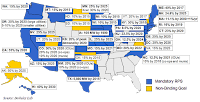Highlights:
- Although the economic struggles of the existing US nuclear fleet are clear, potential solutions to these challenges remain somewhat undefined and unanalyzed.
- Any solution must provide sufficient incentives to generators, reduce uncertainty, and be politically feasible.
- This is a clear situation where a one-size fits all approach will not work – instead, planners will likely have to consider many different policy and regulatory avenues.
- Short term policy fixes may be sufficient to protect the most vulnerable nuclear reactors but more systemic policy reforms are needed for the long-term sustainability of the entire nuclear power fleet.
In the last several months, the announcement of planned retirements at 5.1 GW of nuclear capacity in Illinois and California underscored the challenges facing the U.S.’s nuclear fleet.
While there are many factors at play there are four dominant issues:
- Restructured electricity markets structurally favor short run marginal costs and largely ignore long term considerations
- Low natural gas prices reduce electricity prices in these markets and also challenge the cost effectiveness of nuclear plants in regulated markets
- Continuing growth in renewable energy, especially solar, will only exacerbate these two issues in the long term
- The nuclear fleet is aging, leading to multiple issues including the need for large additional capital expenditures
Although policymakers are increasingly recognizing these issues, questions remain about how to address them.
Read more at Addressing the Plight of Existing Nuclear Retirements, Part 2

No comments:
Post a Comment